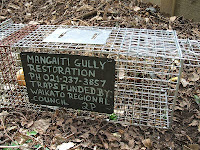 |
| double clip to enlarge |
On the
Coromandel, on two occasions a tap at a filleting bench has been home to a
weta. One had also taken up residence in the watering can hung up in a Ngaio
alongside the bench.
Last
year the Forest and Bird magazine had an article on wetas. It covered artificial
homes advising they be made from minimum 20mm diameter bamboo stem.
3 homes
were created using 15mm stem as this was the only bamboo available. One stem
was hung in the Ngaio while another in a Kanuka nearby, and a third in another
Kanuka at a different location within the section. Two weeks later upon
inspection one of the homes was occupied and after a further two weeks, all had
a resident weta.
Back in
Hamilton, the Mangaiti Gully group removed a fallen Kanuka and found two
naturally occurring weta homes in the trunk. The trunk that contained one of
these homes was secured on an existing Kanuka tree. The other trunk was split
length wise to expose the weta home, hinged for viewing then secured to another
Kanuka.
10
bamboo homes have now been installed amongst the Kanuka where the initial
discovery was made (alongside the walk bridge). A 15mm and a 30 mm stem have
been paired and attached to the Kanuka (see photo) in five locations that do
not appear to have naturally occurring homes. The length of the bamboo stem
varies up to 220mm. After two weeks 2 have been occupied. Both 15mm diam stems and the 2 longest ones, 220 and
180mm.



